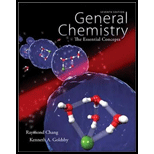
Interpretation:
Equilibrium has to be explained briefly. Two examples of a dynamic equilibrium have to be given.
Concept introduction:
- Chemical equation is the representation of a
chemical reaction , in which the reactants and products of the reactions are represented left and right side of an arrow respectively by using their respective chemical formulas. Chemical equilibrium is achieved when the rate of the forward reaction becomes equal to the rate of the forward reaction.- The concept of dynamic equilibrium occurs in reversible reactions where the concentration and rate of formation of reactants and products are same.
Explanation of Solution
Equilibrium of a reaction where both reactant and products has completely different chemical compositions is termed as chemical equilibrium. In chemical equilibrium, the rate of forward and backward reaction remains same and also reactant and product concentration is constant.
Two examples of a dynamic equilibrium are given below:
Production of nitrogen dioxide
Reaction between carbon monoxide
In both cases the double arrow represents that the reaction is reversible.
Want to see more full solutions like this?
Chapter 14 Solutions
GENERAL CHEMISTRY >IC<
 ChemistryChemistryISBN:9781305957404Author:Steven S. Zumdahl, Susan A. Zumdahl, Donald J. DeCostePublisher:Cengage Learning
ChemistryChemistryISBN:9781305957404Author:Steven S. Zumdahl, Susan A. Zumdahl, Donald J. DeCostePublisher:Cengage Learning ChemistryChemistryISBN:9781259911156Author:Raymond Chang Dr., Jason Overby ProfessorPublisher:McGraw-Hill Education
ChemistryChemistryISBN:9781259911156Author:Raymond Chang Dr., Jason Overby ProfessorPublisher:McGraw-Hill Education Principles of Instrumental AnalysisChemistryISBN:9781305577213Author:Douglas A. Skoog, F. James Holler, Stanley R. CrouchPublisher:Cengage Learning
Principles of Instrumental AnalysisChemistryISBN:9781305577213Author:Douglas A. Skoog, F. James Holler, Stanley R. CrouchPublisher:Cengage Learning Organic ChemistryChemistryISBN:9780078021558Author:Janice Gorzynski Smith Dr.Publisher:McGraw-Hill Education
Organic ChemistryChemistryISBN:9780078021558Author:Janice Gorzynski Smith Dr.Publisher:McGraw-Hill Education Chemistry: Principles and ReactionsChemistryISBN:9781305079373Author:William L. Masterton, Cecile N. HurleyPublisher:Cengage Learning
Chemistry: Principles and ReactionsChemistryISBN:9781305079373Author:William L. Masterton, Cecile N. HurleyPublisher:Cengage Learning Elementary Principles of Chemical Processes, Bind...ChemistryISBN:9781118431221Author:Richard M. Felder, Ronald W. Rousseau, Lisa G. BullardPublisher:WILEY
Elementary Principles of Chemical Processes, Bind...ChemistryISBN:9781118431221Author:Richard M. Felder, Ronald W. Rousseau, Lisa G. BullardPublisher:WILEY





